 By Louise Brinck Harrington June 05, 2004
This is the Alaska Rainforest Sanctuary, located on Wood Road at the old Herring Bay Lumber Company site. My photographer-friend Cheryll and I arrive in plenty of time and spend a few minutes wandering through the new gift shop/interpretive center. We soon make connections with Len Laurance, one of three owners of this new venture and our private tour guide. 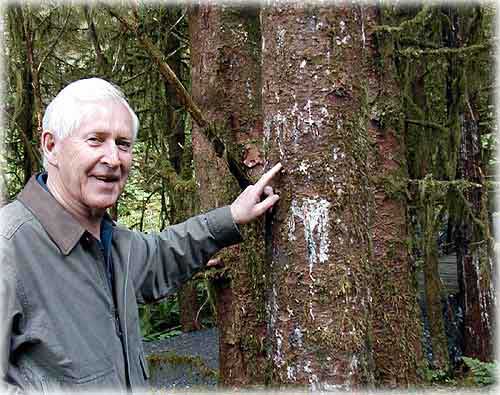 Photo by Cheryll Athorp
But more about that later a tour of the sanctuary is about to start. "Are you ready?" Laurance asks us. Are we ever! The Nature Trail We drive to the shelter/bus-turnaround at the end of Wood Road, where groups of tourists are gathering. This is the beginning of the half-mile nature trail through the rain forest. While we wait for the groups to organize, Laurance fills us in on details about the tour. Each group is limited to 15 people per guide-to keep it small and personal. The groups start off at 15-minute intervals to keep them separate and minimize noise and congestion on the trail. Generally the complete tour takes an hour and forty minutes: an hour on the trail, ten minutes in the sawmill (more about that later) and a half-hour in the interpretive center. Today a total of about 170 people are scheduled to take the tour. 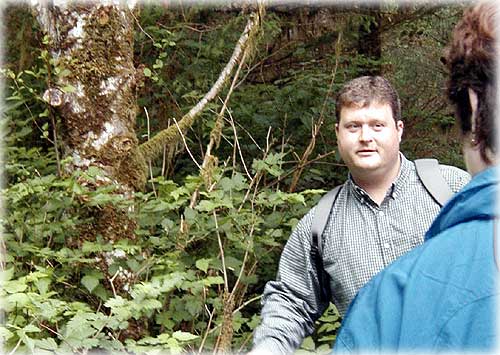 Guide Tony Lund during the tour. Photo by Cheryll Athorp
While Lund points out "Methuselah's beard" and cat tail moss along the trail, Laurance and I stroll behind and chat about the project. Development of the Project How long have you been working on all this? Laurence and his partners Brian Salazar and Chris Singstad "got the concept for the project" on October 1, 2003. "That's when we decided we were going to do something," Laurence explains. The partners formed a corporation and became officially Alaska Rainforest Sanctuary, L.L.C. All longtime Ketchikan residents, the three partners brought different experience and expertise to the project. Laurance brought his experience in tourism and marketing; Salazar, owner of Taquan Air, brought administrative ability; and Singstad contributed business and construction experience. Singstad retired from Anderes Oil after 23 years to work full time on the project and is the only partner with a title: General Manager. On October 15, 2003 Laurance presented the idea to the cruise lines at their annual convention. "That was the key to the whole thing, that the cruise lines would buy in and sell the tour," he says. 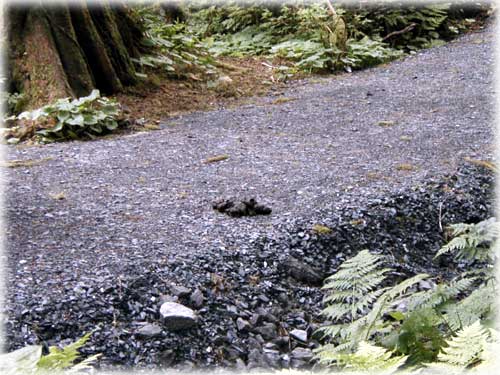 Photo by Cheryll Athorp
I am astounded. You put this all together in less than six months? "The first cruise ship came on May 4th and we were ready for it," Laurance says. He concedes that they put in long hours, had a little luck along the way and left a few small things undone, such as uniforms for the employees that just arrived.
The nature trail emerges on a wide creek estuary and tide-flats. Laurance waves a hand at the stream that splits and wanders through the cove. "The creek didn't have a name," he says. "People would refer to it as the creek at Herring Cove, so we've named it Eagle Creek." Across the creek is the Southern Southeast Regional Aquaculture Association fish hatchery, where three different salmon species-chinook, chum and coho-return to spawn. When fish are running in the creek, Laurance says, eagles are everywhere, and so are the bears. Already bears have been seen on the trail. And one has left a considerable amount of evidence-a big pile of it in fact! An old trapper's cabin can be seen through the trees. The trapper lived in the shack all year around and died about six years ago; when in his prime, however, he trapped mink, marten and wolves from the Herring Cove area. 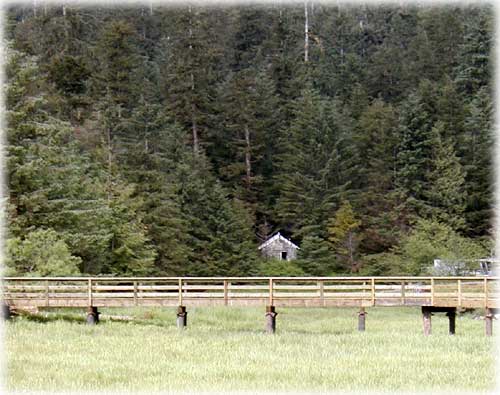 that runs through the grassland near the creek. Photo by Cheryll Athorp
"This was called the log pond, and they would use this old crane with the big grapple on the end to select the logs out of the water," Laurance says as we approach the sawmill. He explains the process used to boom and skid logs. We walk through the mill observing the log deck, round saw blades and green chain. Before restoration of the sawmill site could begin, 85 tons of contaminated soil had to be dug up and shipped out. The soil was contaminated with oil that had been spilled over the years. 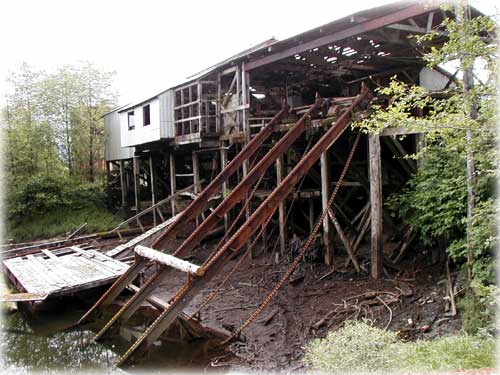 The chain-conveyor system that carried the logs from the log pond up to the log deck. Photo by Cheryll Athorp
The sawmill was built in 1959 and operated by Ben Fleenor and his family. It was called the Herring Bay Lumber Company. Laurance met Fleenor sometime in the 1960s and the two families became good friends. "His daughters used to baby sit my kids," Laurance explains, "and we'd have Sunday dinners together." Fleenor and Laurance would toss around ideas about what could be done with Fleenor's large piece of property after the sawmill closed down-something that would provide a financial return. They discussed various things such as a wildlife refuge but before any idea could come to fruition, Fleenor got sick. He died in 2002. Would Fleenor approve of the final result? He would love this, Laurance
says. "He's probably in seventh heaven, right now, actually,
looking down on us. I feel good about that." 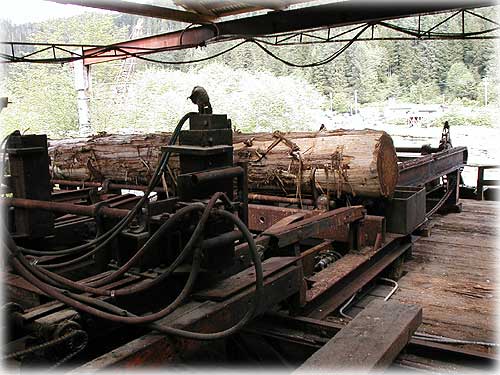 The last log that Ben Fleenor brought into the mill five years ago. Photo by Cheryll Athorp 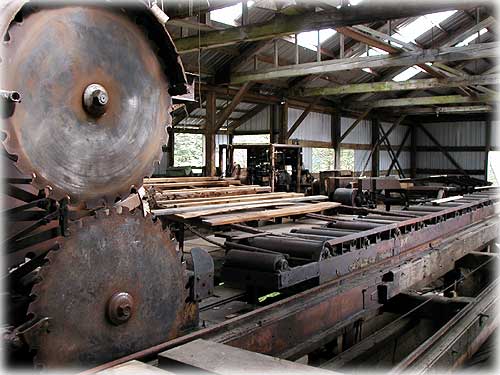 Photo by Cheryll Athorp 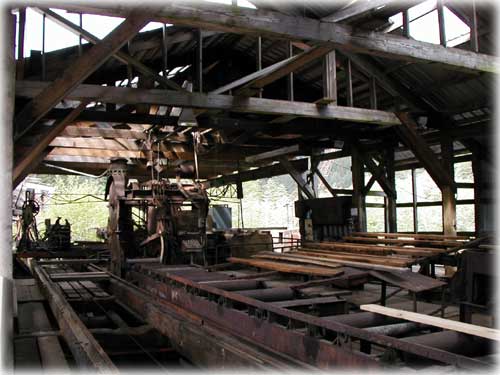 Inside the mill. Photo by Cheryll Athorp 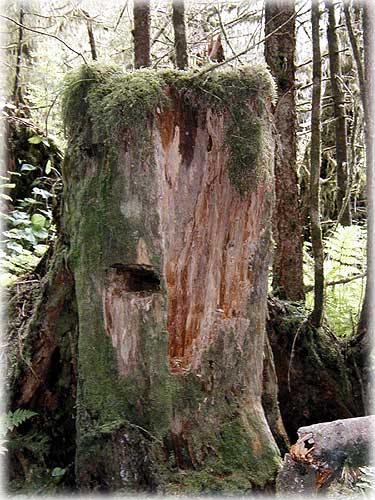 A "springboard hole" made by a long-ago logger in the forest. Photo by Cheryll Athorp Author's note: Tours for local
people are available on Sunday afternoons at 1:30. The cost is
$10.00 per person.
|